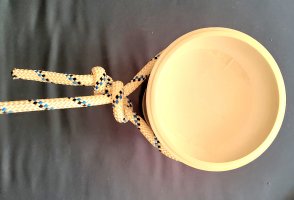The slip knot and the noose knot can both be used for hanging.
It's called the
Noose Knot, which should not be confused with the
Slip Knot or a
Hangman's Noose. The only difference between the
Noose Knot and the
Slip Knot is which end is the sliding end, but it's an important difference (otherwise, they are
exactly the same). The Noose Knot is used for tying a noose – or in other words, a loop that tightens under tension. The Slip Knot is used for tying a temporary stopper knot that's easy to untie. Here is a
video explaining the difference.
A stopper knot must be added on the tail end of the Noose Knot (on its own, the Noose Knot can be unreliable). By the way, a Noose Knot with a stopper knot can also be called an
Arbor Knot. An Arbor Knot is just a Noose Knot with an
Overhand Knot stopper. See these videos for how to tie it:
Video 1,
Video 2.
Apart from the Noose Knot + stopper knot combo, I find that the
Poacher's Knot works very well too. The Poacher's Knot is secure on its own, so a stopper knot is not strictly necessary, but one can be added, of course. Adding one has no drawbacks – it can only make the knot more secure.
I wouldn't use the Hangman's Noose. It's too stiff and doesn't tighten very easily under load.
what avout the material of rope?
Polypropylene (PP) and polyester (PES) are probably the two best choices. Both are very strong and highly stretch-resistant. If you're getting a braided or double-braided rope, look for those materials. Nylon (polyamide) should also work. It's a bit more stretchy, but not so much that it should cause a problem.
Interestingly, static or semi-static climbing ropes are often made of nylon and can be highly stretch-resistant. So if you go for a climbing rope, look for static or semi-static ones, and don't focus too much on the exact material.



